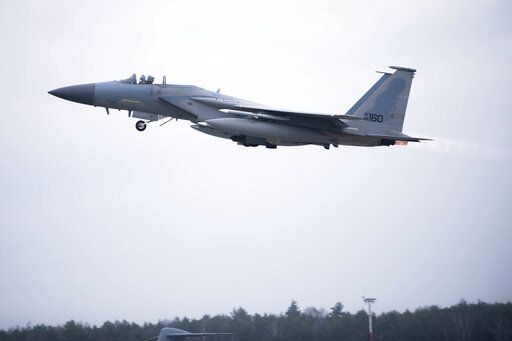EXPLAINER: Why a no-fly zone is unlikely in Ukraine
In this image provided by the U.S. Air Force, a U.S. Air Force F-15C Eagle assigned to the 493rd Fighter Squadron, Royal Air Force (RAF) Lakenheath, takes off in support of North Atlantic Treaty Organization enhanced air policing missions with the Polish Air Force at Lask Air Base, Poland, Feb. 15, 2022. Russia’s attack on Ukraine’s Zaporizhzhia nuclear power plant has renewed calls for NATO to impose a no-fly zone over Ukraine, despite the repeated rejection of the idea by western leaders concerned about triggering a wider war in Europe. (Tech. Sgt. Jacob Albers/U.S. Air Force via AP)
LONDON (AP) — Russia’s attack on Ukraine’s Zaporizhzhia nuclear power plant h as renewed calls for NATO to impose a no-fly zone over Ukraine, despite the repeated rejection of the idea by western leaders concerned about triggering a wider war in Europe.
Ukrainian President Volodymyr Zelenskyy on Friday asked the people of Western Europe to demand that their leaders change course because the shelling of a nuclear power plant in Ukraine threatens the security of the entire continent.
“Immediate closure of the skies over Ukraine is needed,” he said. “Take to the streets and say that you want to live, to live on earth without radioactive contamination. Radiation does not know where the Russian border is.”
The attack did not, as initially feared, result in radiation release.
But military analysts say there is no chance that the U.S., Britain and their European allies will impose a no-fly zone because it could easily escalate the war in Ukraine into a nuclear confrontation between NATO and Russia. Here’s a more detailed explanation about the situation:
WHAT IS A NO-FLY ZONE?
A no-fly zone would bar all unauthorized aircraft from flying over Ukraine. Western nations imposed such restrictions over parts of Iraq for more than a decade following the 1991 Gulf War, during the civil war in Bosnia and Herzegovina from 1993-95, and during the Libyan civil war in 2011.
WHY WON’T NATO TAKE THIS STEP IN UKRAINE?
In simple terms, because it would risk a direct military conflict with Russia that could escalate into a wider European war with a nuclear-armed superpower.
While the idea may have captured the public imagination, declaring a no-fly zone could force NATO pilots to shoot down Russian aircraft.
But it goes beyond that. In addition to fighter planes, NATO would have to deploy refueling tankers and electronic-surveillance aircraft to support the mission. To protect these relatively slow, high-flying planes, NATO would have to destroy surface-to-air missile batteries in Russia and Belarus, again risking a broader conflict.
“The only way to implement a no-fly zone is to send NATO fighter planes into Ukrainian airspace, and then impose that no-fly zone by shooting down Russian planes,” NATO Secretary Jens Stoltenberg said Friday. “We understand the desperation, but we also believe that if we did that, we would end up with something that could end in a full-fledged war in Europe.”
“We have a responsibility as NATO allies to prevent this war from escalating beyond Ukraine,” he said.
WHAT WOULD A NO-FLY ZONE ACHIEVE?
Ukrainian authorities and people cowering night after night in bomb shelters say a no-fly zone would protect civilians — and now nuclear power stations — from Russian air strikes.
But analysts say it’s Russia’s ground forces, not aircraft, that are causing most of the damage in Ukraine.
What Ukrainians actually want is a broader intervention like the one that occurred in Libya in 2011, when NATO forces launched attacks on government positions, said Justin Bronk, a research fellow at the Royal United Services Institute in London. That’s not likely to happen when the opponent is Russia.
“They want to see the West kind of sweeping in and taking out the rocket artillery that’s pummeling Ukrainian cities,’’ Bronk said. “We’re not going to go to war against the Russian army. They are a massive nuclear-armed power. … There is no way that we could possibly model, let alone control, the escalation chain that would come from such an action.”
WHAT IS HAPPENING IN THE SKIES OVER UKRAINE?
Predictions that Russia would quickly control the skies over Ukraine have not come to fruition.
Military experts are wondering why Russia has chosen to leave most of its fixed-wing combat aircraft on the ground during this massive land offensive. One explanation may be that Russian pilots aren’t well trained in supporting large-scale land operations, engagements that require coordination with artillery, helicopters and other assets in a fast-moving environment.
“I think that maybe they’re a little bit worried that that is a very constrained area. It’s not like the Middle East, where there’s all kinds of space to roam around in the air,” said Robert Latif, a retired U.S. Air Force major general who now teaches at the University of Notre Dame.
“They could very easily stray over borders,” he explained. “With both Ukrainian and Russian air defense systems and Ukrainian, what little they have, and Russian airplanes all flying around — that could be a very confusing. I think maybe they’re a little bit worried about actually being able to pull it off.”
___
Associated Press Writer Lorne Cook in Brussels contributed.
___
Follow all AP stories on the Russian invasion of Ukraine at https://apnews.com/hub/russia-ukraine.
Copyright 2022 The Associated Press All right reserved.


